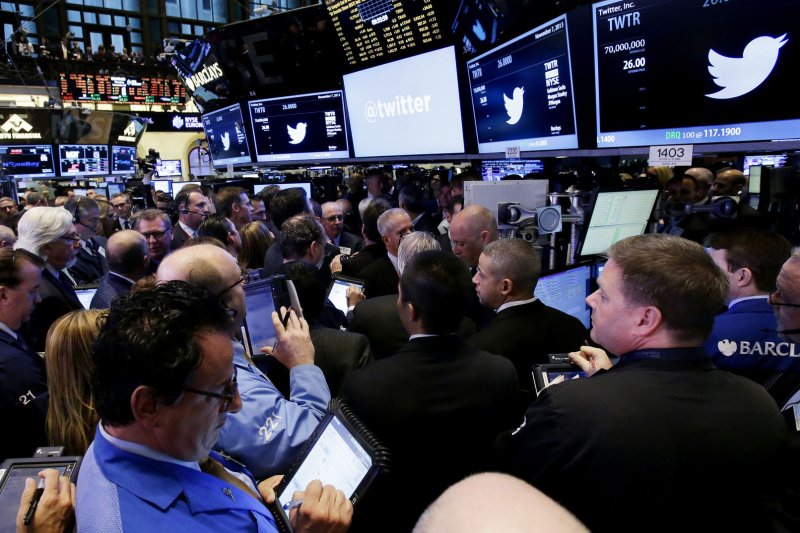1 of 6 | Traders wait for shares of Twitter to be traded for the first time at the Twitter IPO on the floor of the New York Stock Exchange on Wall Street In New York City on November 7, 2013. The NYSE Euronext staged a first-ever weekend test for the initial public offer two weeks ago to avoid reprising the problems with rival Nasdaq's systems that delayed timely orders and ruined Facebook's debut on Wall Street. UPI/John Angelillo |
License Photo
NEW YORK, Nov. 7 (UPI) -- Shares of Twitter topped $50 per share Thursday after opening 73 percent above the initial asking price of $26 on the New York Stock Exchange.
The share price opened at $45.10 and by 8:25 a.m. in New York prices had climbed to $50.09 per share, The Wall Street Journal reported.
At that point, the Journal reported, hedge fund manager Doug Kass said it was time to sell.
"It has an unfavorable risk/reward in the high $40s," Kass said. "If you own it, sell it."
Before Thursday, Kass had said he was "manifestly bullish," on Twitter, the Journal said.
Early reports said most of Twitter Inc. shares were first offered to about 30 large investors.
The small number of large investors -- including mutual funds, hedge funds and some individual clients of the banks underwriting the deal -- will get about three-quarters of the 70 million shares sold in the initial public offering, sources told the Journal.
The lead underwriter, Goldman Sachs, scooped up 38.5 percent of the shares made available in the offering, the Journal said. Morgan Stanley took 20.5 percent and JPMorgan Chase 16 percent, while Bank of America-Merrill Lynch and Deutsche Bank AG earned 8.5 percent.
Those purchases work two ways. Banks, like any investor, gain if the value of their purchases go up. But if Twitter sells its entire over-allotment of shares in its IPO, the banks earn lucrative bonuses.
Goldman Sach's bonus, for example, would be $26.2 million.
Retail investors, including individual customers of some online brokerages and brokerages affiliated with the deal's investment banks, will likely be able to get less than 20 percent of the offering, the people told the newspaper.
By contrast, Facebook Inc. placed 26 percent of its shares through retail channels when it went public May 18, 2012.
The Twitter IPO, trading on the New York Stock Exchange under the symbol TWTR, will have shares priced at $26 apiece for large investors and customers linked to Goldman Sachs Group Inc. and other underwriters.
The offering is expected to raise as much as $2.1 billion for the San Francisco company, which remains unprofitable.
From the opening bell to the close, U.S.-listed IPOs have averaged a one-day "pop," or price rise, of 17 percent this year, the highest since 2000, said Dealogic PLC, which provides information to investment banks.
Six companies so far this year have doubled in price on their first day, Dealogic said.
Facebook is up 85 percent this year. LinkedIn Corp., which offers a professional social-networking website, has climbed 92 percent and the Yelp Inc. online review site and local business search has jumped 253 percent, the Journal said.
Twitter, which opened shop March 21, 2006, has 232 million monthly active users. But it lost $134 million in the first nine months of this year, nearly double the loss of a year earlier.
The number of monthly active users grew 6 percent in the third quarter, down from 7 percent growth in the second quarter and 10 percent in the first quarter.
A large portion of new Twitter users give up on the service within the first three days, a former employee familiar with the data told The New York Times.










